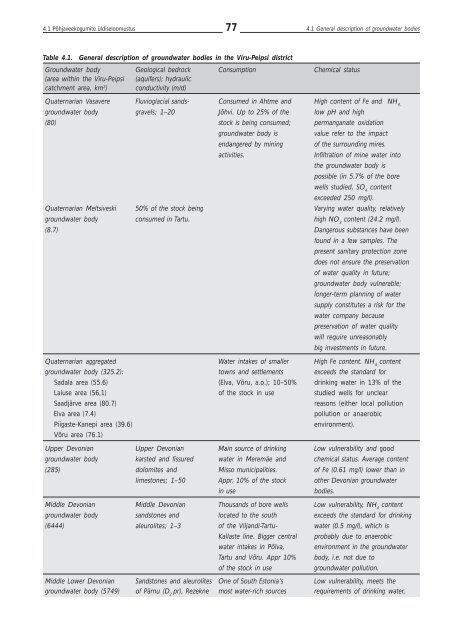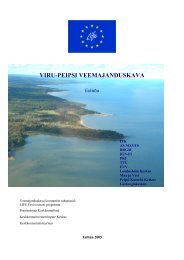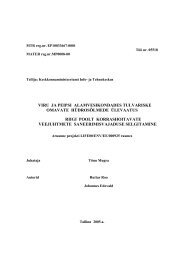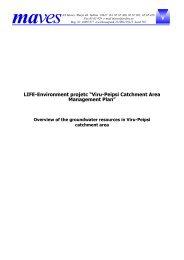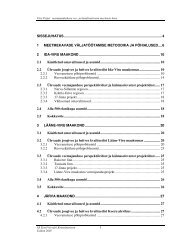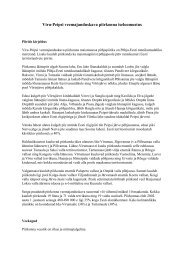Viru-Peipsi veemajanduskava - Keskkonnaministeerium
Viru-Peipsi veemajanduskava - Keskkonnaministeerium
Viru-Peipsi veemajanduskava - Keskkonnaministeerium
Create successful ePaper yourself
Turn your PDF publications into a flip-book with our unique Google optimized e-Paper software.
4.1 Põhjaveekogumite üldiseloomustus<br />
77<br />
4.1 General description of groundwater bodies<br />
Table 4.1. General description of groundwater bodies in the <strong>Viru</strong>-<strong>Peipsi</strong> district<br />
Groundwater body Geological bedrock Consumption Chemical status<br />
(area within the <strong>Viru</strong>-<strong>Peipsi</strong> (aquifers); hydraulic<br />
catchment area, km 2 ) conductivity (m/d)<br />
Quaternarian Vasavere Fluvioglacial sands- Consumed in Ahtme and High content of Fe and NH 4,<br />
groundwater body gravels; 1–20 Jõhvi. Up to 25% of the low pH and high<br />
(80) stock is being consumed; permanganate oxidation<br />
groundwater body is<br />
value refer to the impact<br />
endangered by mining of the surrounding mires.<br />
activities.<br />
Infiltration of mine water into<br />
the groundwater body is<br />
possible (in 5.7% of the bore<br />
wells studied, SO 4<br />
content<br />
exceeded 250 mg/l).<br />
Quaternarian Meltsiveski 50% of the stock being Varying water quality, relatively<br />
groundwater body consumed in Tartu. high NO 3<br />
content (24.2 mg/l).<br />
(8.7) Dangerous substances have been<br />
found in a few samples. The<br />
present sanitary protection zone<br />
does not ensure the preservation<br />
of water quality in future;<br />
groundwater body vulnerable;<br />
longer-term planning of water<br />
supply constitutes a risk for the<br />
water company because<br />
preservation of water quality<br />
will require unreasonably<br />
big investments in future.<br />
Quaternarian aggregated Water intakes of smaller High Fe content. NH 4<br />
content<br />
groundwater body (325.2): towns and settlements exceeds the standard for<br />
Sadala area (55.6) (Elva, Võru, a.o.); 10–50% drinking water in 13% of the<br />
Laiuse area (56,1) of the stock in use studied wells for unclear<br />
Saadjärve area (80.7)<br />
reasons (either local pollution<br />
Elva area (7.4)<br />
pollution or anaerobic<br />
Piigaste-Kanepi area (39.6)<br />
environment).<br />
Võru area (76.1)<br />
Upper Devonian Upper Devonian Main source of drinking Low vulnerability and good<br />
groundwater body karsted and fissured water in Meremäe and chemical status. Average content<br />
(285) dolomites and Misso municipalities. of Fe (0.61 mg/l) lower than in<br />
limestones; 1–50 Appr. 10% of the stock other Devonian groundwater<br />
in use<br />
bodies.<br />
Middle Devonian Middle Devonian Thousands of bore wells Low vulnerability, NH 4<br />
content<br />
groundwater body sandstones and located to the south exceeds the standard for drinking<br />
(6444) aleurolites; 1–3 of the Viljandi-Tartu- water (0.5 mg/l), which is<br />
Kallaste line. Bigger central probably due to anaerobic<br />
water intakes in Põlva, environment in the groundwater<br />
Tartu and Võru. Appr 10% body, i.e. not due to<br />
of the stock in use<br />
groundwater pollution.<br />
Middle Lower Devonian Sandstones and aleurolites One of South Estonia’s Low vulnerability, meets the<br />
groundwater body (5749) of Pärnu (D 2<br />
pr), Rezekne most water-rich sources requirements of drinking water,


